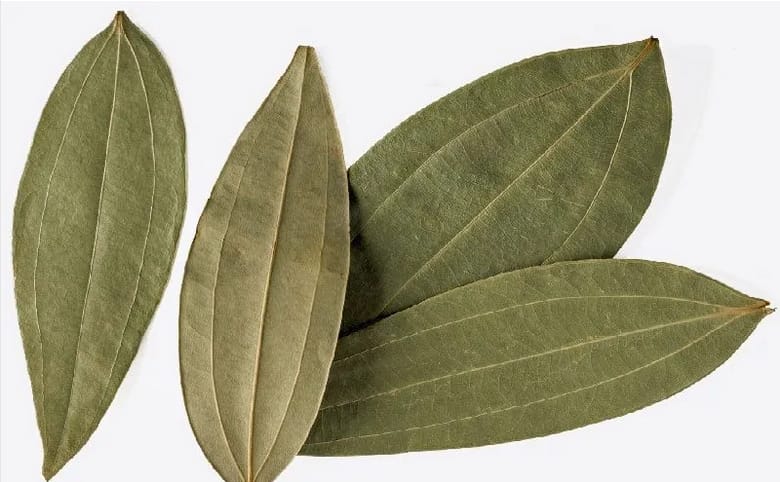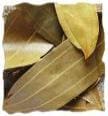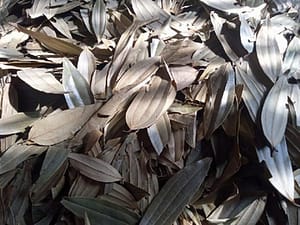Description
Indian Cassia also known as Tejpat (Cinnamomum Tamala) is a small to moderately sized ever green tree. The leaves of this tree is the spice having clove like taste and a faintly pepper like odour. The tree has height up to 7.5 mtr with zigzag branching, trunk up to 95 cm girth, bark rough, dark grey to reddish brown in colour.
Origin and Distribution
Cinnamomoum tamala is mostly occurring in the tropical and sub-tropical Himalayas extending to North East India up to an altitude of 2000 meters MSL. It also grows in Nepal, Bangladesh and Myanmar. The leaves are harvested when the tree attains an age of 10 years which continue for a century. Mature leaves are collected during October to March.
Indian Name of Spices
Hindi : Tejpat Bengali : Tejpata Gujarati : Tamalapatra Kashmiri : Tejpata Malayalam : Tamalapatram Marathi : Darchini Punjabi : Tejpat Sanskrit : Tamalaka (Tejpatra) Tamil : Talishappattiri Telugu : Talisapatri Urdu : Tejpat
Foreign Name of Spices
Burmese : Thitchabo Chinese : Chai gui French : Laurier desIndes German : Indisches Lorbeerblatt Japanese : Tamara-nikkei Tezipatto Russian : Malabarskaya korista
MEDICINAL PARTS
The dried leaves of Cinnamomum Tamala plant/tree are called Tejpatta and used as a spice and in ayurvedic medicine. The flowers of this plant are also used in folk medicine.
PHYTOCHEMISTRY (Chemical Composition)
The leaves (Tej Patta) of Cinnamomum Tamala contain a volatile oil, which contains phytochemical constituents such as MONOTERPENES and SESQUITERPENES.
The essential oil and oleoresins in Cinnamomum Tamala leaves contain EUGENOL. EUGENOL is responsible for the anti-bacterial and anti-fungi activities of the Indian Bay Leaf (Tejpatta). So, it can also be used in human yeast infections.
PHARMACOLOGICAL ACTIONS
Tejpatta (Indian Bay Leaf) is an antioxidant. When it is added in fat rich food, it increases the shelf-life by preventing oxidative degradation of lipids. So, it can become the alternative to synthetic antioxidants used in food preservation.
Furthermore, it acts as a digestive stimulant, which is likely to induce the appropriate secretion of digestion enzymes. Therefore, it helps to maintain the proper digestion and enhances assimilation (absorbing the nutrients from the food).
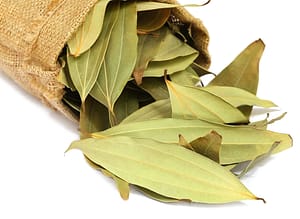
Medicinal Properties
- Carminative
- Anti-spasmodic
- Immunostimulant
- Antioxidant
- Anti-Diabetic
- Anti-Inflammatory
- Anticancer
- Antimicrobial
- Anti-tubercular
- Cardiac Stimulant
- Blood purifier (correctly detoxifier)
- Anodyne
- Mild Diuretic
- Galactagogue
- Digestive stimulant
Ayurvedic Properties
| RASA (Taste) | KATU (Pungent), MADHURA (Sweet) |
| GUNA (Main Quality) | LAGHU (Light), TIKSHNA (Sharp) |
| VIRYA (Potency) | USHNA (Hot) |
| VIPAKA (Resultant) | KATU (Pungent) |
| PRABHAVA (Action) | Digestive |
| DOSHA KARMA (Effect on Humors) | Pacifies KAPHA & VATA |
| Dhatu (Tissue) Effect | RASA, RAKTA, MEDAS |
| Organs Effect | Stomach, Intestine, Liver |
Tejpatta Therapeutic Indications
- Intestinal Gas, Bloating, Belching and abdominal distension
- Abdominal pains and cramps
- Diarrhea
- Fever
- Common cold
- Asthma
- Uterus detoxification after delivery (along with cinnamon and green cardamom seeds)
- Atonicity of uterus or reduced the elasticity of the uterine wall
Benefits & Medicinal Uses
Tejpatta (Indian Bay Leaf) is an important ingredient of Trijataka, which is an excellent remedy for the abdominal diseases. Individually, Tejpatta is also used due to its action on Vata Dosha and Kapha Dosha. In the ancient India, spices were used to prevent water-borne diseases and one of these spices is Tejpatta. It also induces sweating and digestive stimulant in higher dosage.
Gas & Abdominal Distension
Tejpatta is an excellent remedy to remove the gas from the human gut. It is anti-flatulent, antispasmodic, and digestive. It is likely to prevent gas formation in the gut when added to the food. You should remember it should only be used in cases of Vata and Kapha predominance. In people having intestinal gas along with gastritis or acidity, then it is not the suitable remedy.
Abdominal Pain & Cramps
Tejpatta has antispasmodic and carminative action, which helps to treat abdominal pain and cramps. It is more likely to be effective when pain or cramps are due to accumulated gas in the abdomen.
High Cholesterol & Triglycerides
Tejpatta reduces cholesterol and helpful in the treatment of Hyperlipidemia. We can use it along with herbs like Dalchini (Cinnamon), Laung (clove), and Trikatu herbs.
Dosage & Administration
| The general dosage of Tejpatta (Indian Bay Leaf) is as follows. | |
| Children | 10 to 20 mg per Kg body weight * |
| Adults | 500 mg to 3 grams * |
| Lactation | 500 mg * |
| Maximum Possible Dosage | 6 grams Per Day (in divided doses) |
| * Twice a day with water | |
| Best Time to Take: With food or After Food | |
Tejpata (Bay Leaf) Uses
Tejpata, a simple aromatic spice. But its benefits for health and beauty is enormous. To get the best benefits, it’s important to know the uses. Let’s know them.
- For Diabetes: Swallow 1/4-1/2 teaspoon Tejpata powder with water after lunch and dinner to control diabetes
- Cold Symptoms: Boil Bayleaf in hot water and make a cup of tea with it. Drinking tea with this aromatic spice cures cold soon.
- Skin problems: Oil of Tejpata has anti-fungal and anti-bacterial properties. It eases skin infections, bruises, cuts, and insect bites.
- Headache or Arthritis pain: A glass of boiled Tejpata water helps to cure headache or arthritis pain.
- Good Sleep: Few drops of bay leaf extract in water before going to bed helps to get sound sleep.
- Hair Problems: boil 200 grams of Tejpata in one Liter of water until it becomes one-fourth. Massage your scalp with this water and leave it for half an hour before washing your hair.
- Skin Care: Tejpata oil is great for skincare. Boil the leaf with olive oil and use it on the skin.
Safety Profile
Tejpatta (Indian Bay Leaf) is non-toxic and considerably safe when used in food. Its dosage less than 1 gram per day is also likely to be safe when used for therapeutic purposes. The dosage more than 1 gram per day may induce sweating and dieresis in some people.
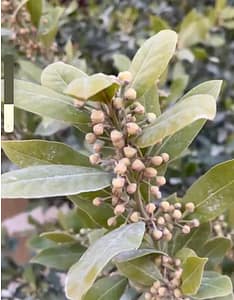
Tejpatta Side Effects
The most common side effect of Tejpatta is excessive sweating (perspiration) that occur with higher dosage. In some people already having gastric troubles, it can worsen the following symptoms:
- Heartburn
- Burning sensation in the abdomen
- Sour belching
- Burning sensation after defecation
Pregnancy & Lactation
Pregnancy: The safety profile of Tejpatta is not well-established in pregnancy. However, it might be safe in the food amounts, which should be less than 500 mg per day.
In ayurvedic medicine, it is used to prevent miscarriage in some women with the weakened uterine wall. It provides strength to the uterine musculature and supports the pregnancy. According to this point of view, it might be safe during pregnancy.
Lactation: Tejpatta has Galactagogue action, which means it increases breast milk supply. Therefore, it can be used during lactation and considerably safe for both mother and child.
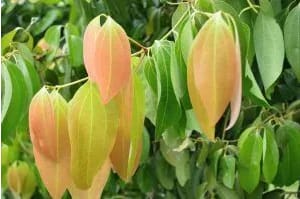
*GI (Geographical Indication)* –
Bay leaves, also known as Tejpata, hold significant recognition and admiration worldwide for their exceptional flavor and medicinal benefits. These leaves, derived from the Cinnamomum Tamala plant, have become the first product from the state of Uttarakhand to receive a Geographical Indication (GI) tag. The GI tag serves as an indicator for products that possess specific geographical origin, quality, or reputation.
Tejpata is primarily cultivated in the hill districts of Uttarakhand, thriving at altitudes ranging from 1000 to 2000 meters in shaded areas. The unique microclimatic conditions and soil composition of these regions contribute to the distinct aroma and flavor profiles of these bay leaves. This geographical specificity is what makes them eligible for the coveted GI tag.
The cultivation of Tejpata plays a pivotal role in the livelihoods of over 10,000 farmers in Uttarakhand. These farmers directly depend on the production and trade of Tejpata for their sustenance. By engaging in Tejpata cultivation, they not only preserve traditional agricultural practices but also contribute to the socioeconomic development of the region.
The GI tag awarded to Tejpata showcases its exceptional quality and authentic origin, reinforcing its position as a valuable and cherished agricultural product. Consumers and businesses worldwide can now identify and appreciate the unique attributes and benefits associated with Tejpata from Uttarakhand.


